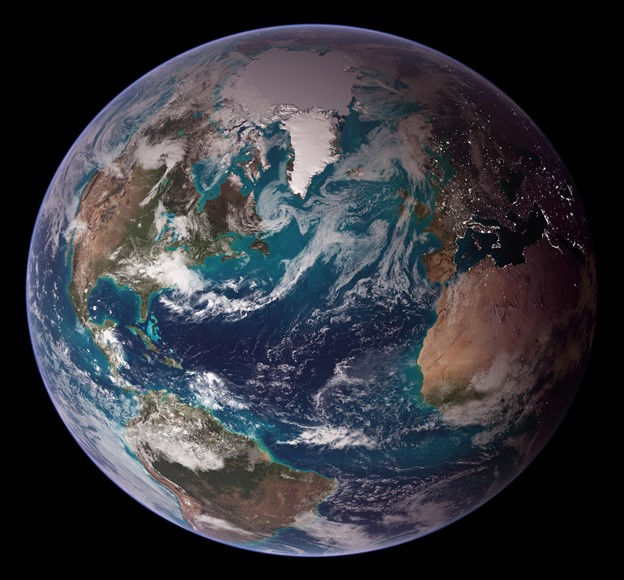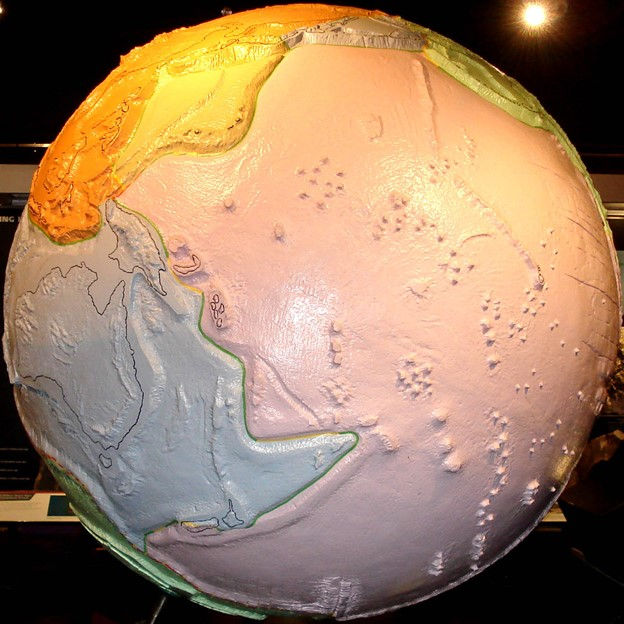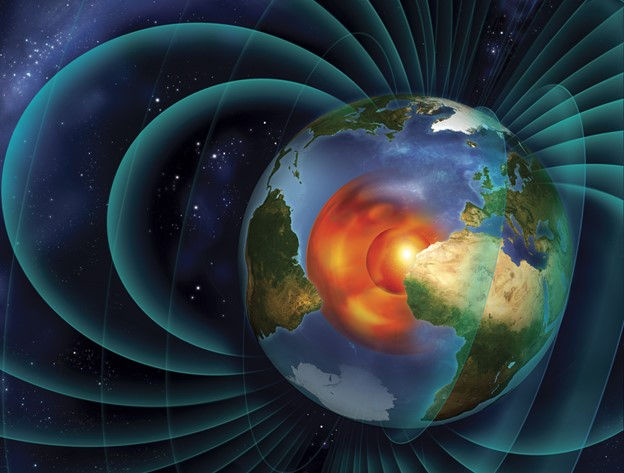Our planet, a seemingly solid blue marble against the cosmic canvas, hides a symphony of secrets beneath its surface. Science, ever the intrepid explorer, has ventured into these depths, returning with jaw-dropping revelations that rewrite our understanding of Earth and our place within it. Here are five such insights that crack open the crust of our existence:
1. Tectonic Tango: A Planet on the Move:

Forget fixed continents – Earth's surface is a vibrant salsa of interlocking plates, jostling and grinding in a mesmerizing dance driven by the fiery furnace at its core. This geological waltz sculpts mountains, unleashes volcanoes, and even whispers tales of wandering continents. From the Himalayas' majestic rise to the Grand Canyon's gaping maw, plate tectonics explains the Earth's dramatic topography, reminding us that our seemingly immovable ground is, in fact, a vibrant, ever-shifting stage.
Determining the "first discoverer" of plate tectonics is a complex subject with no single definitive answer. The theory developed gradually over centuries through the contributions of numerous scientists and observations. Here's a breakdown of its evolution:
Early Observations:
16th Century: Abraham Ortelius and Francis Bacon mentioned concepts of moving continents, suggesting landmasses might have been connected in the past.
19th Century: Antonio Snider-Pellegrini observed earthquake patterns and proposed dividing the Earth's surface into mobile blocks.
Key Players in the 20th Century:
Alfred Wegener (1912) Proposed the theory of continental drift, suggesting continents broke apart and drifted over time. While ultimately proven inaccurate, it laid the groundwork for later developments.
Frank Taylor (1910): Observed parallel trends in mountain ranges across continents, hinting at past connections.
Arthur Holmes (1929) Suggested mantle convection within Earth's core could drive continental movement, paving the way for the modern understanding of plate tectonics.
Harry Hess (1960s): The seafloor spreading hypothesis proposed that mid-ocean ridges act as conveyor belts, constantly generating new oceanic crust and pushing older portions outwards, thereby supporting the concept of mobile tectonic plates.
J. Tuzo Wilson (1960s): Introduced the concept of transform faults, explaining how plates move horizontally past each other, further solidifying the plate tectonics theory.
Therefore, attributing the discovery solely to one individual wouldn't be accurate. It was a collaborative effort, with each scientist building upon the observations and theories of their predecessors.
Instead of focusing on a single "discoverer," it's more fitting to acknowledge the cumulative scientific journey that led to the current understanding of plate tectonics, a testament to the ongoing scientific discovery and collaboration process.
2. Climate Carousel: A Delicate Balancing Act:

Earth isn't just a rock flinging through space; it's a fragile bubble of life protected by a delicate veil of atmosphere. This atmospheric cloak, woven from a tapestry of gases, plays a complex game with the sun's energy, trapping just the right amount of heat to create a livable oasis. But like a carousel spinning too fast, too much of one element – greenhouse gases like CO2 – throws the system out of whack, triggering the scary dance of global warming. Understanding this delicate equilibrium is crucial, for it is critical to mitigating climate change and ensuring the future of this precious oasis we call home.
The history of understanding Earth's climate and its delicate balance is fascinating and lengthy. Here are some key points to consider:
Early Observations:
Ancient Greece: Philosophers like Aristotle speculated about the influence of the sun and air on Earth's climate.
Medieval Times: Records of droughts, floods, and other extreme weather events suggest awareness of climate variability.
17th-18th Centuries: Scientists like Edmond Halley and Joseph Fourier began understanding the role of greenhouse gases in trapping heat.
The Rise of Climate Science:
19th Century: Scientists like Svante Arrhenius calculated the warming effect of CO2, laying the foundation for understanding climate change.
Early 20th Century: Milutin Milanković identified cyclical changes in Earth's orbit and their impact on climate (Milankovitch cycles).
Mid-20th Century: The development of atmospheric circulation models and data collection tools allowed for more detailed climate studies.
Climate Change in the Spotlight:
1960s-1970s: Growing evidence of a warming trend and the potential for human influence sparked increasing public and scientific concern.
1988: The United Nations and the weather experts (World Meteorological Organization) joined forces to create the "IPCC," a science club for climate change. This was a HUGE deal because it meant everyone finally started working together to figure out what's causing climate change and how to stop it. It was like turning on a giant spotlight on the problem, making it impossible to ignore anymore.
21st Century: Continued research provides increasingly detailed climate projections and drives efforts to mitigate and adapt to climate change.
Connecting to the Metaphor:
The "Climate Carousel" metaphor aptly captures Earth's climate system's interconnectedness and constant movement. Its "delicate balancing act" highlights the critical balance between greenhouse gases, Earth's orbit, and other factors influencing global temperatures. Understanding this history can help us appreciate the complexity of climate change and the urgency of action to maintain a habitable planet.
Remember, while "Climate Carousel" is not a specific historical concept, it can be a helpful tool to engage with the complex and evolving knowledge of our planet's climate system.
3. Life's Ubiquitous Tango: A Universe Teeming with Possibility:

We once held dear the belief that Earth was the solitary cradle of life, a lone emerald in the cosmic desert. But science, once again playing the role of the magician, has pulled a rabbit out of its cosmic hat – the discovery of life in unexpected corners of our solar system and beyond. Extremophiles, tiny life forms thriving in the scorching vents of the oceans or the frigid deserts of Mars, challenge our definitions of life and expand the canvas of possibility. This revelation whispers of a universe teeming with biological diversity, urging us to rewrite our story as just one chapter in the grand saga of life.
Let's dive into this cosmic kaleidoscope and explore the endless possibilities that bloom within its expansive depths:
1. Beyond our Blue Marble: Forget the singular stage of Earth; our universe is a teeming theatre overflowing with celestial actors. Billions of galaxies, each ablaze with stars and swirling with planets, whisper tales of unfathomable diversity. On distant worlds, alien landscapes might cradle exotic life forms, dancing to different rhythms of starlight and gravity. The thought of civilizations gazing at foreign constellations, contemplating our existence as we do theirs, stirs the soul with cosmic kinship.
2. Whispers of Life in the Void: Once, Earth held the lone torch of life in the cosmic darkness. But science, intrepid explorer, has revealed life's tenacity in the most unexpected corners. Microbes dance in hydrothermal vents, thriving in volcanic heat. Extremophiles cling to life in icy Martian deserts, defying the bounds of our understanding. These whispers of life across the cosmos shatter the isolation we once perceived, hinting at a universe teeming with biological diversity waiting to be discovered.
3. Time, Space, and the Quantum Playground: Our familiar notions of time and space twist and fold in the cosmic playground. Imagine traversing galaxies in the blink of an eye, thanks to wormholes or manipulation of the fabric of spacetime. Quantum mechanics, on the other hand, plays a surreal game of chance, where particles vanish and reappear, defying logic and opening doors to parallel realities.
4. The Unseen Symphony of Energy: Our senses perceive but a sliver of the universe's grand orchestra. Dark matter and dark energy, unseen presences, conduct the cosmic symphony, influencing the dance of galaxies and whispering of mysteries yet to be unveiled. Technology may grant us the ears to hear their subtle melody, unlocking another layer of the universe's secrets.
5. The Human Journey, Evolving: We, the curious children of the cosmos, are not static observers. Our knowledge, technology, and understanding evolve with each passing generation. Imagine harnessing the power of fusion for interstellar travel, shaping planets to suit our needs, or even bridging the gap between biological and artificial consciousness. The possibilities for our advancement, woven into the fabric of this teeming universe, are as limitless as the stars themselves.
The phrase "A Universe Teeming with Possibility" is not just a catchy tagline; it's a beacon of hope, a reminder that our reality is far grander, more diverse, and more mysterious than we could ever have imagined. It compels us to explore, to question, and to push the boundaries of our understanding. So, let us keep gazing at the night sky, not fearing the unknown, but with awe and excitement, for the universe whispers: "The possibilities are endless. Dare to discover them."
4. The Breath of Ancient Photosynthesis: A Legacy We Inhale:

The air we breathe, essential for every fluttering heartbeat and blooming flower, isn't a birthright but a hard-won legacy. Billions of years ago, Earth's atmosphere was a toxic soup, devoid of the life-giving oxygen we cherish. Then came the cyanobacteria, tiny green alchemists who mastered the art of photosynthesis, transforming the air with each gulp of sunlight. Their tireless work, over eons, crafted the oxygen-rich haven we now enjoy, shaping the foundation of our existence. With every breath, we inhale a testament to their ancient magic, a reminder of our profound connection to the silent heroes of Earth's past.
"The Breath of Ancient Photosynthesis" is a poetic phrase that encapsulates the profound connection between the air we breathe and the silent heroes of Earth's past: the cyanobacteria. Let's delve deeper into this inspiring image:
1. A Life-Giver's Legacy: Imagine Earth, billions of years ago, shrouded in a toxic haze, devoid of the oxygen that nurtures our existence. Then enter the cyanobacteria, tiny green alchemists who mastered the art of photosynthesis. With each gulp of sunlight, they transformed the atmosphere, exhaling the life-giving breath we now inhale. Their tireless work, stretching over eons, crafted the oxygen-rich haven we call home.
2. An Interwoven Tapestry: Each breath we take is a testament to their legacy, a link in the chain that connects us to these ancient pioneers. We walk upon landscapes sculpted by their oxygen-fueled ecosystems; their descendants photosynthesize in every leaf, and their legacy whispers in the rustle of the wind. Every living creature on Earth, from the soaring eagle to the deepest-dwelling fish, owes its existence to this ancient breath.
3. A Responsibility Shared: Recognizing this profound connection demands a shift in perspective. We are not just occupants of Earth; we are part of a grand tapestry woven by generations of life, responsible for safeguarding the delicate balance they forged. Protecting our forests, nurturing biodiversity, and mitigating climate change become acts of honoring their legacy and ensuring the continuity of this precious breath.
4. A Source of Inspiration: Their story also whispers boundless possibility. What potential lies within us if these tiny organisms could transform a toxic planet into a haven? Can we, like them, become alchemists in our own right, transforming challenges into opportunities, negativity into hope? Their tenacity and transformative power serve as a beacon, urging us to strive for a better future for ourselves and all beings who share this breath.
5. A Call to Action: "The Breath of Ancient Photosynthesis" is not just a poetic turn of phrase; it's a call to action. It reminds us to cherish the air we breathe, to honor the legacy that gave it life, and to act as responsible stewards of this precious gift. Let us carry this awareness with every breath and strive to leave our legacy that future generations will inhale with gratitude and respect.
So, the next time you take a deep breath, remember the ancient alchemists who gifted it to us. Let their story inspire you, empower you, and guide you towards a future where the breath of life continues to flourish for generations to come.
5. The Magnetic Marvel: An Invisible Shield Protecting Us:

Earth isn't just a spinning rock; it's a giant magnet cloaked in an invisible force field that shields us from the solar wind's wrath. This magnetic bubble, generated by the churning molten iron in our core, deflects charged particles that could wreak havoc on our technology and disrupt communication, leaving us vulnerable and isolated. Understanding this magnetic marvel is crucial for space exploration, for it holds the key to venturing beyond our atmosphere and protecting our technological lifeline.
These are but a few glimpses into the treasure trove of knowledge science has unlocked about Earth. From the tectonic tango to the whisper of ancient life, every insight rewrites our narrative, revealing a planet far more dynamic, interconnected, and teeming with possibility than we ever imagined. With each discovery, we gain a more profound respect for the wonder of Earth and our responsibility to ensure its continued health and sustainability. Earth is not just a stage for our existence but a complex, vibrant story waiting to be unraveled, one that whispers not just of our past but of a future teeming with potential and possibility.
So, let us continue to listen, explore, and be awed by the secrets Earth holds, for in understanding its story, we know our own.
"The Magnetic Marvel" paints a captivating picture of our planet shrouded in an invisible shield, a silent protector against the solar wind's wrath. Let's explore the mysteries and marvels of Earth's magnetic field:
1. A Churning Core, a Cosmic Shield: Imagine Earth's core, a swirling cauldron of molten iron. This dynamo generates electric currents, creating a colossal magnet that extends far beyond our atmosphere. This invisible fortress, the magnetosphere, deflects charged particles from the sun, shielding us from cosmic blasts and protecting our technology from harm.
2. Aurora's Dazzling Dance: When these charged particles, unable to penetrate the magnetosphere, collide with atmospheric gasses, they ignite a celestial show – the aurora borealis and aurora australis. These mesmerizing curtains of light, dancing across polar skies, are not just a spectacle; they are whispers of the cosmic battle raging unseen, a testament to the magnetosphere's tireless vigilance.
3. Compass' Guiding Spirit: This magnetic marvel has guided explorers, its invisible lines etched onto compass needles for centuries. From intrepid Vikings navigating uncharted seas to satellites orbiting our planet, the magnetosphere has served as a silent guide, ensuring our journeys through the cosmic ocean.
4. A Gateway to Space Exploration: Understanding the magnetosphere is crucial for venturing beyond Earth's embrace. Astronauts rely on its protective shield during spacewalks, and spacecraft must navigate its currents cautiously to avoid damage. By deciphering its secrets, we unlock the doors to deeper space exploration, venturing further into the cosmic wilderness.
5. A Reminder of Interconnectedness: Our planet isn't just a rock floating in space; it's a participant in the grand cosmic ballet. The sun's activity, solar storms, and the dance of other celestial bodies all interplay with the magnetosphere, reminding us of Earth's intricate connection to the vast universe.
The Magnetic Marvel is more than just a scientific phenomenon; it symbolizes Earth's resilience, protection, and interconnectedness. It whispers tales of cosmic battles, guides earthly and celestial journeys, and promises us endless mysteries to unfold. So, let us continue to study its secrets, respect its power, and be awestruck by the silent marvel that shields our fragile existence in the grand theatre of the universe.

Comments